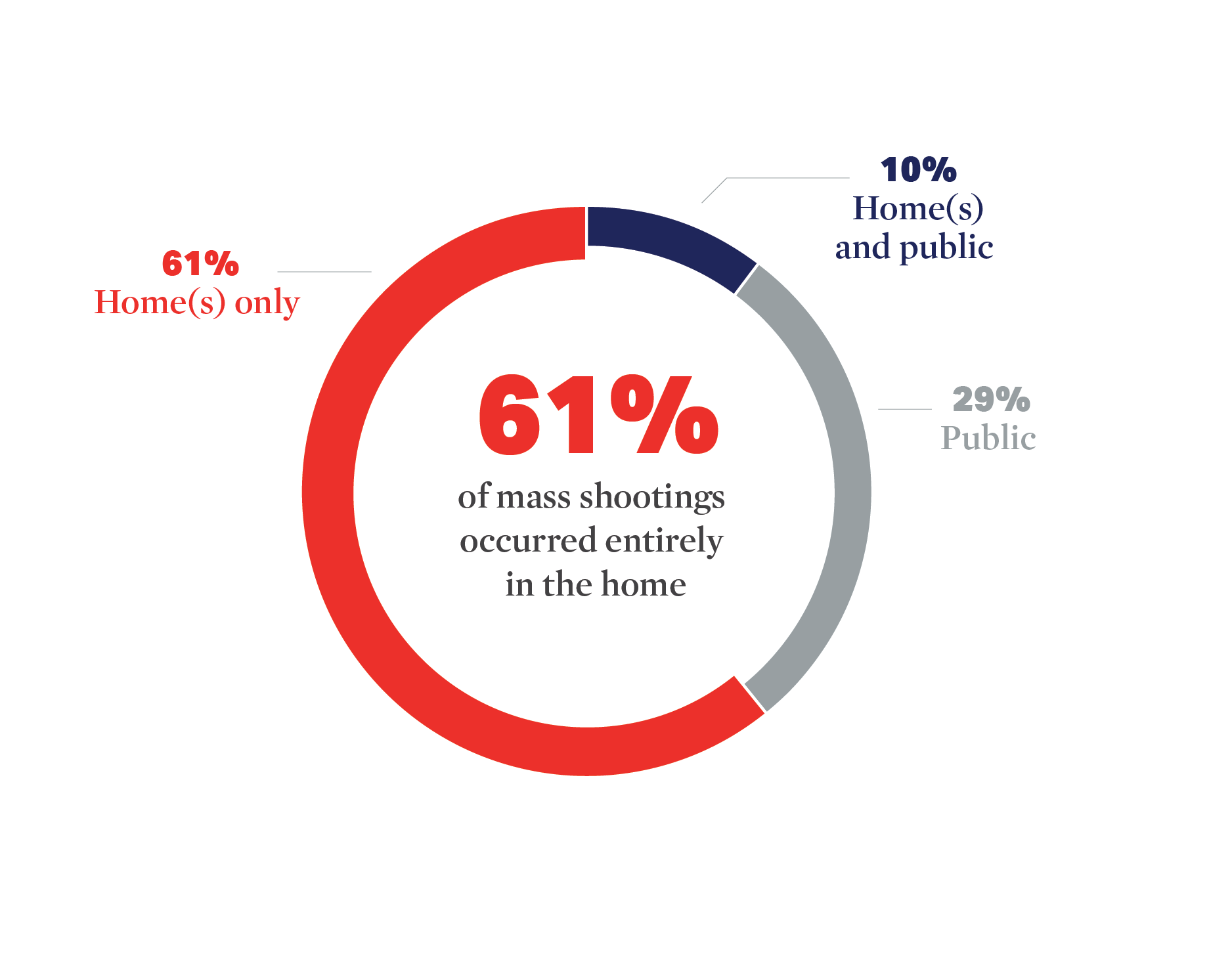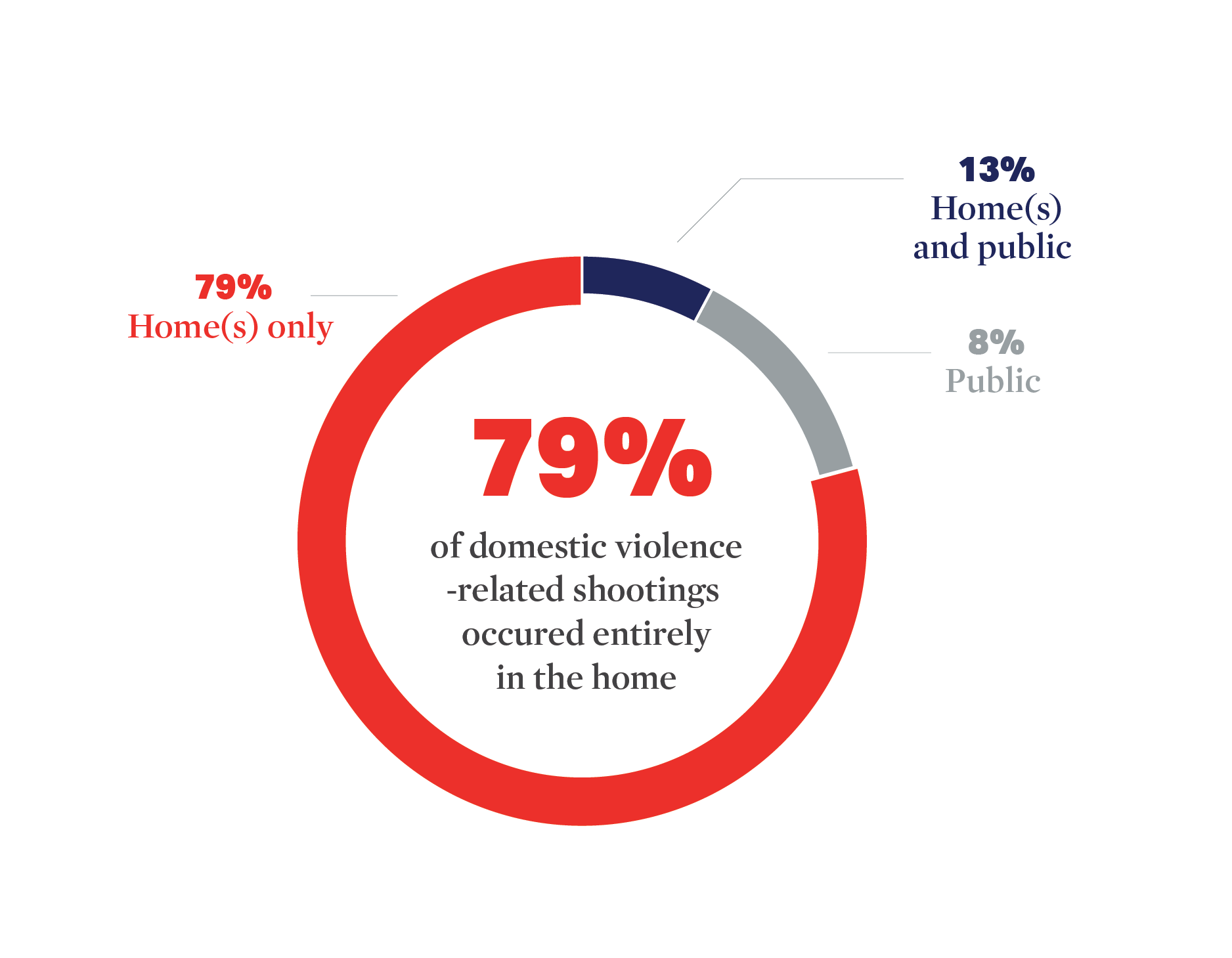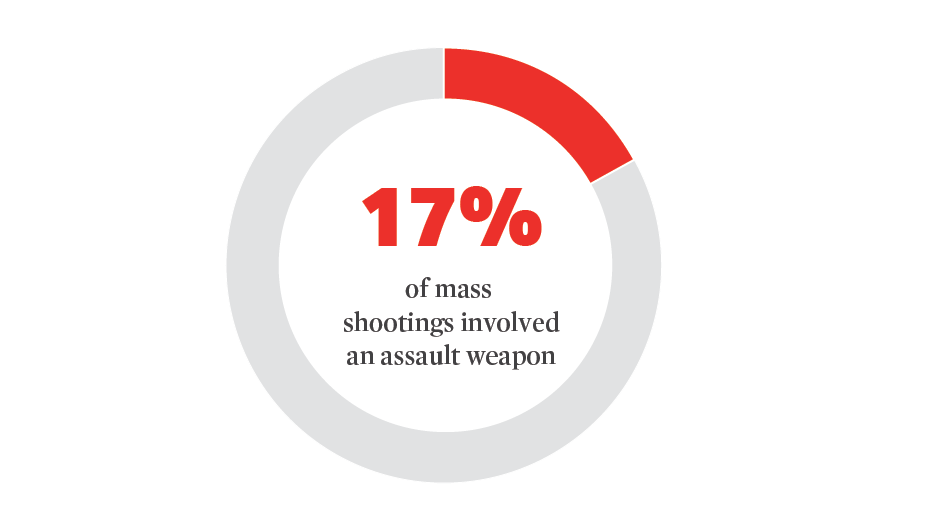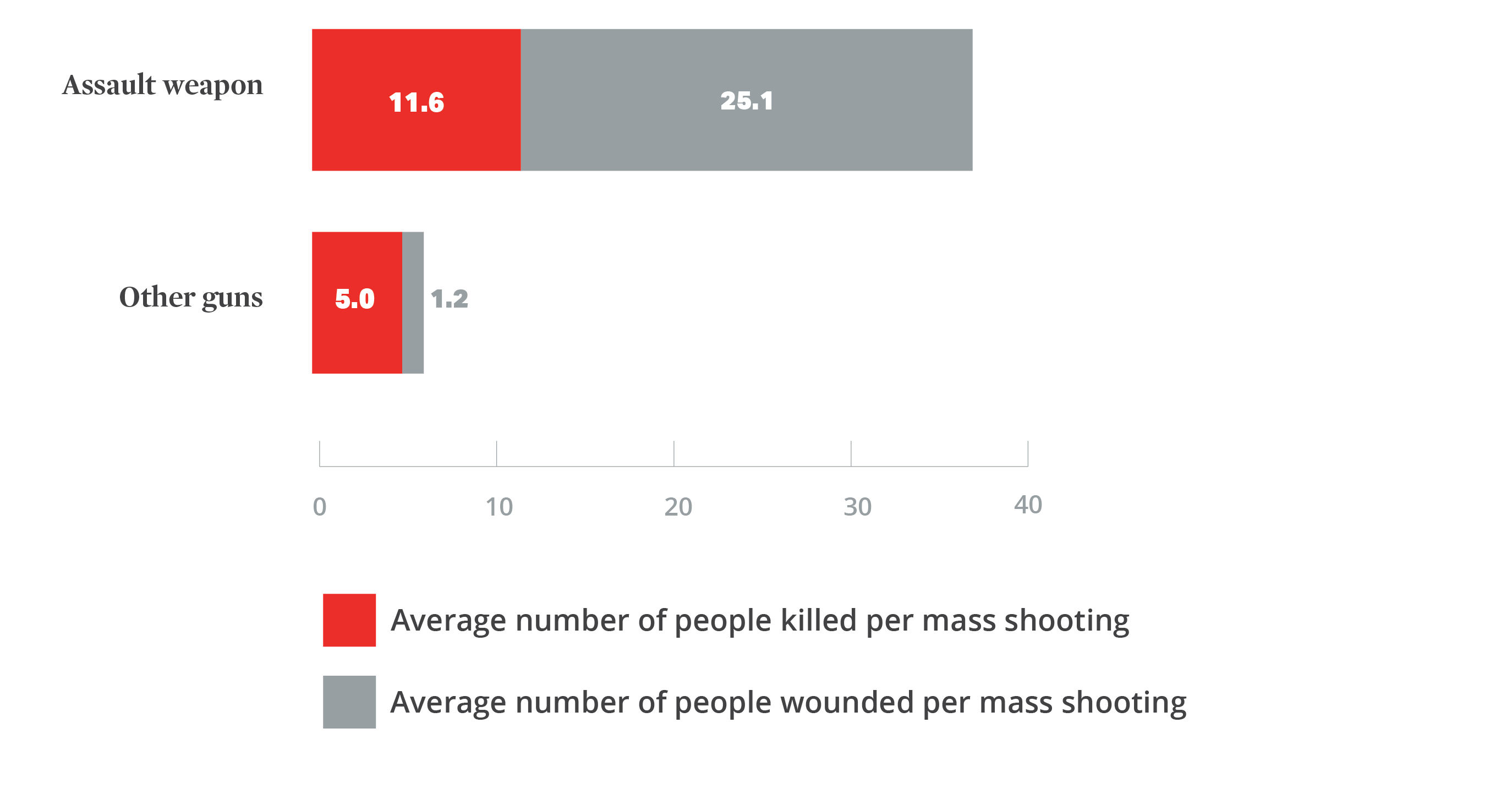Ten Years of Mass Shootings in the United States
An Everytown for Gun Safety Support Fund Analysis
Introduction
In the decade between 2009 and 2018, the horrific scenes of mass shootings have haunted the nation’s collective conscience. Each breaking news alert floods the nation with grief and anger at this senseless, preventable violence. The United States is not the only country with mental illness, domestic violence, or hate-fueled ideologies, but our gun homicide rate is 25 times higher than other high-income countries.Erin Grinshteyn and David Hemenway, “Violent Death Rates in the US Compared to those of the Other High-Income Countries, 2015,” Preventive Medicine 123 (June 2019): 20–26. The difference is easy access to guns. This connection is not just theoretical. US states with weaker gun laws and higher gun ownership rates have higher rates of mass shootings.Paul M. Reeping et al., “State Gun Laws, Gun Ownership, and Mass Shootings in the US: Cross Sectional Time Series,” BMJ 364 (March 2019): 1542.
While the popular perception may be that mass shootings are the nation’s largest share of gun deaths, the data tells a different and more complex story. In reality, mass shootings are the tip of the iceberg of this country’s gun violence crisis. More than 99 percent of gun deaths in the US are from shootings other than mass shootings.Mass shootings result in an average of 112 firearm deaths each year (2009 to 2018), compared to 34,538 deaths from all types of gun violence each year(2009 to 2017*). *CDC death data is not yet available for 2018. Nevertheless, because of the high number of casualties and often extensive and horrific media coverage associated with them, each mass shooting sends shockwaves of pain and harm through families, communities, and the nation. Just like the daily gun violence that contributes to the more than 100 gun deaths each day in the US, mass shootings are largely preventable through evidence-based policy interventions.
This analysis reflects a compilation of 10 years (2009 to 2018) of original data on mass shootings in the United States, sourced from media reports and official police and court records. These records enable unique insights into the circumstances of mass shootings. For full details on data collection, see our methodology.
Mass shootings are not a random, inevitable element of American life today. Rather, this report illuminates trends that can help point lawmakers to strategies to curb these tragedies. These trends include that mass shootings are often:
- perpetrated by someone who was legally prohibited from possessing a firearm;
- perpetrated by someone who displayed prior warning signs;
- intermingled with acts of domestic violence; and
- far deadlier when they involve assault weapons and high-capacity magazines.
Definition of a mass shooting
Everytown defines a mass shooting as any incident in which four or more people are shot and killed, excluding the shooter.
By this definition, the United States experiences an average of 19 mass shootings every year, ranging from 15 in 2010 and in 2014 to a high of 24 in both 2011 and 2013. However, there exists no consensus on the definition of a mass shooting. Counts under other definitions range from a dozen per year to nearly one mass shooting every day depending on factors such as casualty thresholds or whether the mass shooting was in public or not.
By any count, the number of mass shootings that plague this country is far too high, and the counts are just a small fraction of the lives left forever changed after the tragedy of a mass shooting. To read more on Everytown’s definition, see our methodology.
Ten-Year Overview
1 in 4 mass shooting victims were children and teens.
In the decade between 2009 and 2018, 1,121 Americans were killed and 836 more were wounded in 194 mass shootings, an average of 19 shootings each year. Among the casualties were 309 children and teens killed and 194 more wounded, as well as 19 law enforcement officers killed and 23 wounded. These numbers are staggering, yet they represent just a small portion of the lives forever changed after a mass shooting shakes a community with terror and grief.
Number of mass shootings each year

In nearly all mass shootings over this period, the shooter was an adult man who acted alone.176 mass shooting incidents involved a lone shooter, compared to 18 with multiple shooters; 196 of the 209 mass shooters with known gender were male; 201 out of 208 with known age were over age 18. Forty-one percent of mass shootings, or 80 incidents, ended with the shooter dying by suicide, and another 18 shooters were killed by responding law enforcement. The remaining 111 mass shooters were taken into custody by law enforcement, while the outcomes and identities of 11 remain unknown.
Mass shootings have been resulting in more people shot in each incident in recent years.
While mass shootings have not increased in frequency in recent years, the death and injury counts of each shooting have been rising. In the first five years included in this analysis, an average of seven people were shot per incident. In the second half of the decade, the average grew by 86 percent, up to 13 people shot per incident. While much of this increase was driven by the devastatingly high toll of the 2017 Las Vegas mass shooting, even when this incident is excluded, the second five-year period still saw a 15 percent increase.
Most mass shootings happened in private homes.
The archetypal mass shooting is one that occurs in a public place such as a school or a bar. While mass shootings in public places tend to receive more media attention, the majority of these shootings actually occur in private homes.
Between 2009 and 2018, 61 percent of mass shootings occurred entirely in the home and another 10 percent occurred partially in the home and partially in a public location. Twenty-nine percent occurred entirely in public spaces like schools, malls, or bars. Of these public mass shootings, the majority (61 percent) occurred in a place of business such as a restaurant or retail store, and 13 percent occurred in a school. Of the 76 mass shootings that occurred at least partially in a public place, 47 occurred in a place of business, and 10 occurred in a school. These public mass shootings were deadlier: While 40 percent of mass shootings occurred at least in part in public, they resulted in 52 percent of all mass-shooting deaths over this 10-year period.

Many mass shooters were prohibited from possessing firearms.
In the absence of a comprehensive federal law that requires background checks on all gun sales across the country, criminals, domestic abusers, and other prohibited people can easily avoid background checks in 29 states simply by buying guns from unlicensed sellers—including strangers they meet online.
1 in 3 mass shooters were legally prohibited from possessing firearms at the time of the shooting.
The harm posed when people who should not have guns can easily avoid a background check is particularly evident in mass shootings, where one in three shooters were legally prohibited from possessing firearms at the time of the shooting, whether because they had a felony conviction, had been adjudicated mentally ill by a court of law, or had a domestic violence restraining order, among other reasons.Everytown was able to gather data on shooters’ prohibited status for 177 of 220 mass shooters. Incidents in which prohibited status is unknown, often because the shooter’s identity remains unknown, have been excluded from this calculation. These shootings resulted in 318 deaths and 87 injuries, or one in three deaths and one in 10 injuries, that may have been prevented with a stronger, more comprehensive background check system.These deaths resulted from the 64 incidents involving at least one shooter who was prohibited.
Closing loopholes in our federal and state background check laws can prevent guns from ending up in the hands of those who are legally prohibited from having a firearm. Read more about how background checks save lives and protect communities here.
Mass shooters often displayed warning signs.
Perpetrators of mass shootings often display warning signs before the violence, such as engaging in recent acts or threats of violence or violating a protection order. These warning signs present opportunities for intervention that could save lives. In fact, in more than half (54 percent) of the mass shootings in this analysis, a shooter exhibited at least one dangerous warning sign prior to the shooting. Combined, shooters demonstrating dangerous warning signs took 536 lives and wounded 250 more, equating to more than half of all mass shooting deaths and a third of all injuries.Everytown was able to gather data on warning signs for 168 of 194 mass shootings. Incidents in which warning sign data is unknown, often because the shooter’s identity remains unknown, have been excluded from this calculation.
In 54% of mass shootings, the shooter exhibited dangerous warning signs before the shooting.
The fact that so many mass shooters displayed warning signs prior to their acts of violence highlights the opportunities to intervene and prevent these tragedies. Extreme Risk laws are one such opportunity. Sometimes referred to as “red flag” laws, these laws empower loved ones and law enforcement who recognize warning signs to petition a court to temporarily restrict a person’s access to firearms when they pose a significant risk of using them to cause harm. Research shows Extreme Risk laws are effective in saving lives, especially in cases of firearm suicide. Read more about the research here.
Domestic violence was a part of most mass shootings.
Although many people think of mass shootings as random acts of violence, this analysis shows that most mass shootings are not at all random: In at least 54 percent of mass shootings between 2009 and 2018, the perpetrator shot a current or former intimate partner or family member during the mass rampage. These domestic violence-related mass shootings resulted in at least 532 people shot and killed and 83 people wounded, amounting to almost half of all mass shooting deaths and one in ten injuries.
In at least 54% of mass shootings, the perpetrator shot an intimate partner or family member.
Nearly 3 in 4 children and teens killed in mass shootings died in an incident connected to domestic violence.
Too often, children and teens are the victims of domestic violence mass shootings: Of the 309 children and teens killed in all mass shootings in the past 10 years, nearly three in four (72 percent) died in an incident connected to intimate partner or family violence.
The findings about domestic violence-related mass shootings and where mass shootings tend to occur are interlinked. Nearly all of these domestic violence-related shootings involved at least one victim in a private home (92 percent), and 79 percent of them occurred there entirely and never moved into a public space.

In at least 61 mass shootings, the shooter had a known previous history of domestic violence. In 49 of those mass shootings, the shooter shot and killed an intimate partner or family member as part of their rampage.
Intimate partner and family violence are far more likely to turn deadly when guns are involved. Abusers with firearms are five times more likely to kill their female victims, and guns further exacerbate the power and control dynamic used by abusers to inflict emotional abuse and exert coercive control over their victims.Jacquelyn C. Campbell et al., “Risk Factors for Femicide in Abusive Relationships: Results from a Multisite Case Control Study,” American Journal of Public Health 93, no. 7 (July 2003): 1089-1097. Read more about the deadly nexus between domestic violence and guns and the policies that help prevent domestic homicides here.
Mass shootings involving assault weapons or high-capacity magazines were far deadlier.
When assault weapons and high-capacity magazines were used in mass shootings, they resulted in far more deaths and injuries. Between 2009 and 2018, the five deadliest mass shooting incidents in the US all involved the use of assault weapons and high-capacity magazines: Las Vegas, Orlando, Newtown, Sutherland Springs, and Parkland.Las Vegas, Nevada: 58 deaths; Orlando, Florida: 49 deaths; Newtown, Connecticut: 27 deaths; Sutherland Springs, Texas: 25 deaths; Parkland, Florida: 17 deaths.
Assault weapons and high-capacity magazines were disproportionately used in public mass shootings. Of the shootings with known weapon type, 73 percent of those that involved an assault weapon and/or high-capacity magazine occurred in public compared to 45 percent of those that involved a handgun.
Handguns. Most mass shootings—81 percent—involved the use of at least one handgun, and 60 percent involved only handguns.Gun type is known for 155 of 194 mass shootings. The 39 incidents in which gun type is unknown were excluded. 127 mass shootings involved the use of at least one handgun, and 95 involved exclusively handguns. At least 16 shooters used a handgun with a high-capacity magazine.

Every bed was full. We had people in the hallways, people outside, and more people coming in. Dr. Jay Coates, a trauma surgeon in Las VegasAssociated Press, “'Every Bed Was Full': Vegas Hospitals Swamped with Victims,” Tampa Bay Times, October 3, 2017, https://bit.ly/2WmtKKs.
Assault weapons. Assault weapons are generally high-powered, semiautomatic firearms designed to fire rounds at a greater velocity than most other firearms, and, when combined with high-capacity magazines, they enable a shooter to fire a devastating number of rounds over a short period. In the 10 years from 2009 to 2018, there were at least 26 mass shootings (17 percent of those with known weapon data) that involved the use of an assault weapon, resulting in 302 deaths and 653 injuries. In other words, mass shootings that involved an assault weapon accounted for 32 percent of all mass shootings deaths and 82 percent of injuries. While not used in the majority of mass shootings, when they were, it left six times as many people shot than when there was no assault weapon.

Assault weapons led to 6x as many people shot per mass shooting

High-capacity magazines. High-capacity magazines allow a shooter to fire more rounds without pausing to reload. The more rounds a shooter can fire consecutively, the more gunshot wounds they can inflict during an attack.Peter Rhee et al., “Gunshot Wounds: A Review Of Ballistics, Bullets, Weapons, And Myths,” Journal of Trauma and Acute Care Surgery 80, no. 6 (June 2016): 853-67. While nearly every assault weapon used in a mass shooting over this period included a high-capacity magazine, an additional 19 mass shootings involved the use of high-capacity magazines with other guns. In total, at least 40 mass shootings involved high-capacity magazines, which resulted in 399 people killed and 688 people wounded. Of those 40 mass shootings that involved high-capacity magazines, nearly three-fourths occurred in public places. Of the 40 mass shootings that involved high-capacity magazines, 24 occurred entirely in public, and five occurred both in a private home and in public. As a whole, the mass shootings we know involved the use of high-capacity magazines resulted in nearly five times as many people shot on average as those that did not.Type of magazine used is known in 68 incidents. Incidents in which magazine capacity was unknown have been excluded.

High-capacity magazines led to 5x as many people shot per mass shooting

Between 2009 and 2018, the 5 deadliest mass shootings all involved assault weapons and high-capacity magazines.
A growing body of research shows that states can reduce gun violence by limiting access to assault weapons and high-capacity magazines. States with restrictions on magazine size experience mass shootings at less than half the rate of states without restrictions. Sam Petulla, “Here Is 1 Correlation between State Gun Laws and Mass Shootings,” CNN, October 5, 2017, https://cnn.it/2J4sWCC. Study defines mass shootings as incidents where three or more victims, not including the shooter, are killed or injured with a firearm. Another study estimated that mass shooting deaths were 70 percent less likely to occur when the federal prohibition on assault weapons and high-capacity magazines was in effect.Charles DiMaggio et al., “Changes in US Mass Shooting Deaths Associated with the 1994-2004 Federal Assault Weapons Ban: Analysis of Open-Source Data,” Journal of Trauma and Acute Care Surgery 86, no. 1 (January 2019): 11-19. In fact, when looking at possible factors such as socio-demographics and gun laws, laws restricting magazine size were by far the strongest predictor of a state’s rate of mass shootings.Sam Petulla, “Here Is 1 Correlation between State Gun Laws and Mass Shootings,” CNN, October 5, 2017, https://cnn.it/2J4sWCC. Study defines mass shootings as incidents where three or more victims, not including the shooter, are killed or injured with a firearm. Read more about assault weapons and high-capacity magazines and the policies that help prevent their use in gun violence here.
Mass shootings cause indelible harm to survivors and communities.
While I have no physical scars, I have had increased anxiety and hypervigilance in my daily life since that day. Outdoor events are difficult for me, and I constantly think of an escape plan, wherever I am. We need change, so no one has to be afraid of “fireworks” ever again. Geena Marano, a survivor of the Las Vegas mass shooting.Submitted to Everytown for Gun Safety Moments that Survive digital story wall. https://everytown.org/momentsthatsurvive/. Read more of Geena’s story here: https://everytown.org/tribute/geena-marano/.
The destructive reach of a mass shooting stretches far beyond those killed and wounded, damaging the well-being of survivors, their families, and communities. Studies of survivors from various mass shootings consistently find that mass shootings harm the mental health of both direct survivors and community members, including psychological symptoms like post-traumatic stress and depression.Sarah R. Lowe and Sandro Galea, “The Mental Health Consequences of Mass Shootings,” Trauma Violence Abuse 18, no. 1 (January 2017): 62-82. Even those living far away, such as those watching coverage of a mass shooting on the news, can experience increased fear of crime or victimization and uncertainty about their safety at school and in the community.Ibid.
Mass shooting response also burdens health care systems, local economies, and taxpayers. One researcher estimated that the cost of the Las Vegas mass shooting would be at least $600 million after tallying costs such as medical and mental health care, police work, work loss and employer expenses, and quality of life.John Haltiwanger, “Las Vegas Shooting Recovery Will Cost At Least $600 Million,” Newsweek, October 2, 2017, http://bit.ly/2pYrnB6. The fear of mass shootings only increases these costs—one investigation found that since Columbine, at least $811 million federal dollars have been spent to help school districts hire security guards.Mark Follmann et al., “The True Cost of Gun Violence in America,” Mother Jones, April 15, 2015, http://bit.ly/2BPkcOx.
Conclusion
Only through understanding the true nature of mass shootings can we begin to seek evidence-based solutions. Lawmakers should pass legislation requiring background checks on all firearm sales, temporarily removing firearms through Extreme Risk laws, keeping firearms out of the hands of domestic abusers, and restricting the purchase, possession, and manufacture of assault weapons and high-capacity magazines.


